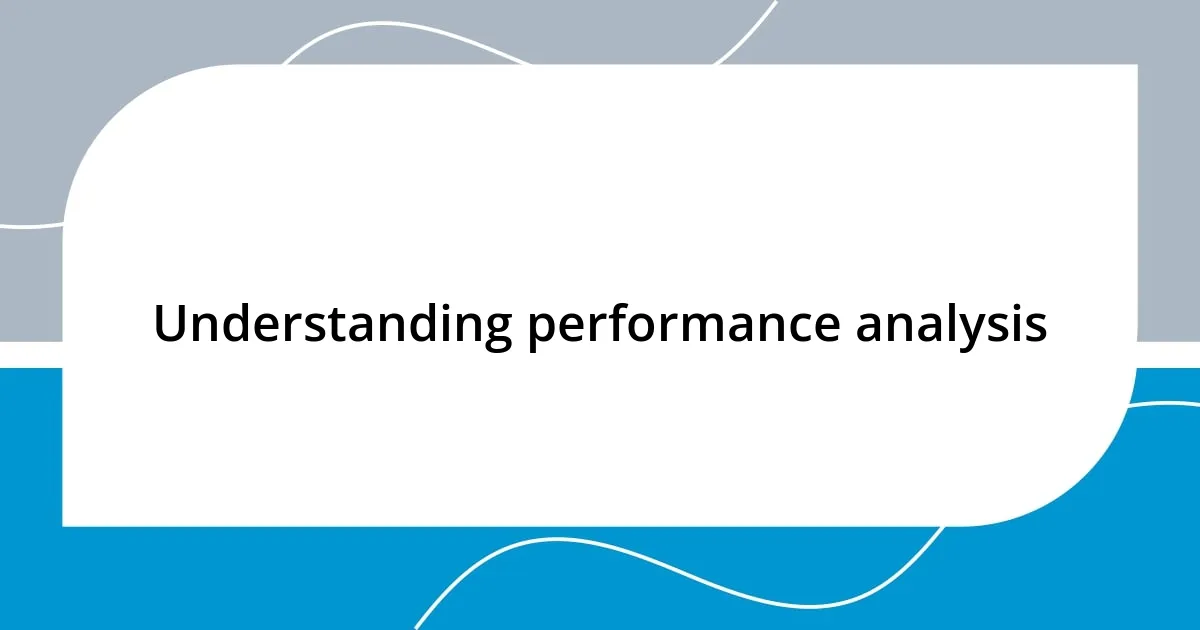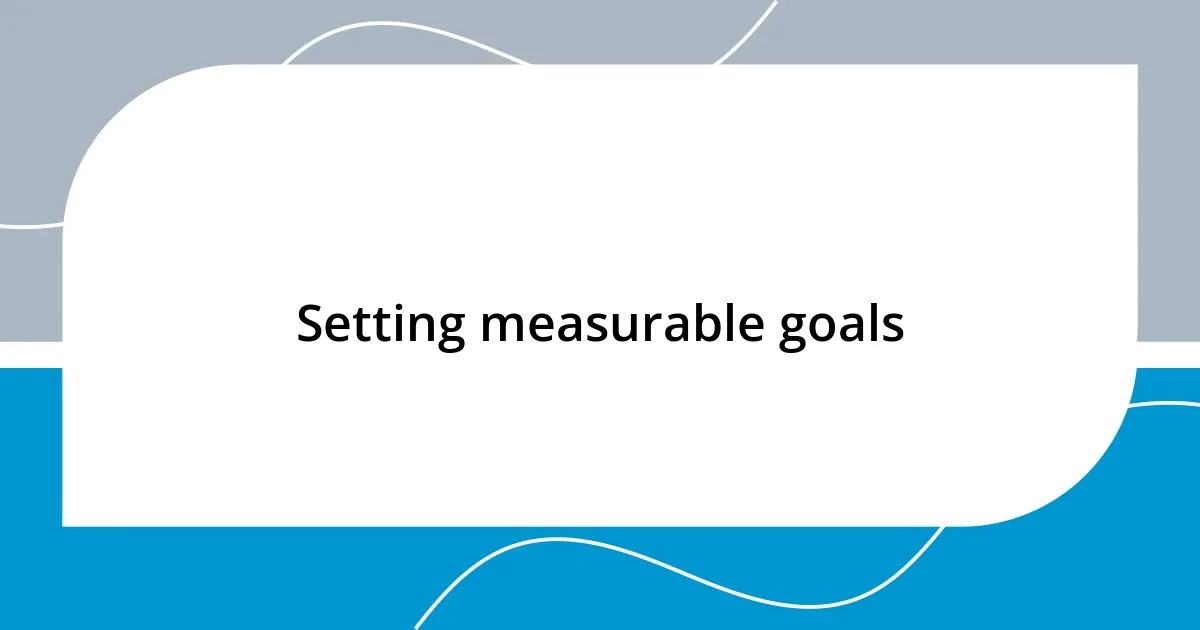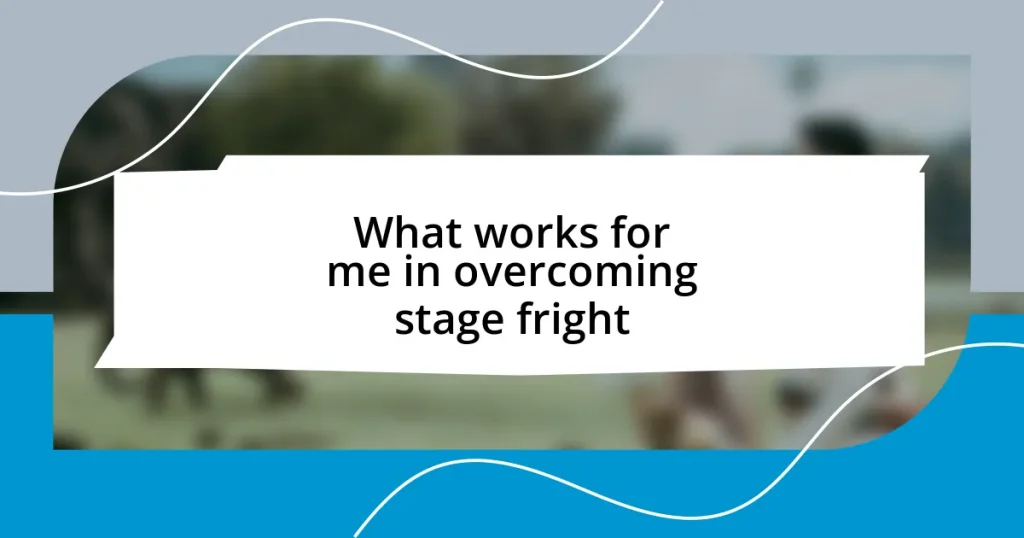Key takeaways:
- Performance analysis helps identify strengths and weaknesses, fostering personal growth and improved engagement.
- Setting measurable goals enhances clarity and accountability, leading to structured development and significant progress.
- Collecting diverse data, including self-reflections and peer feedback, creates a comprehensive understanding of performance dynamics.
- Regularly reviewing progress allows for reflection on achievements and adjustments, reinforcing motivation and continuous improvement.

Understanding performance analysis
Performance analysis is all about looking at what worked and what didn’t, and I find it to be an enlightening experience. I remember a time when I meticulously reviewed my presentation skills. The feedback I received was eye-opening; I had no idea how often I was fidgeting, which distracted my audience. Have you ever experienced a moment where you thought you nailed it, only to realize there was room for improvement?
Digging deeper into my own performances, I’ve learned that identifying patterns can lead to better outcomes. For instance, after reflecting on my last few meetings, I noticed I tend to dominate conversations, which can shut down collaboration. Realizing this made me rethink my approach—am I truly engaging with my team, or am I just talking at them?
Emotions play a significant role in performance analysis, too. Each time I analyze a performance, there’s this wave of vulnerability mixed with excitement. It’s like peering into a mirror that reflects both my strengths and areas needing growth. Have you ever felt that tension between pride and the desire to improve? Embracing those feelings can transform the way we view our journeys and our capabilities.

Setting measurable goals
Setting measurable goals is a crucial step in my performance analysis. I recall when I started tracking specific metrics for my writing projects, such as word count and deadline adherence. Not only did this help me stay organized, but it also provided me with tangible proof of my progress. Have you ever thought about how tracking your efforts can reveal surprising insights into your productivity?
It’s fascinating to think about how measurable goals can bring clarity to our ambitions. For example, I set a goal to improve my speaking skills by preparing for five public speaking engagements over the span of three months. By counting each performance and gathering feedback, I found myself pushing past my comfort zone. This focus transformed how I approached my speeches, allowing me to refine my style and boost my confidence. Isn’t it amazing how a little structure can lead to significant growth?
When I reflect on past experiences, I see how critical it is to not just set goals but to make them quantifiable. Aiming for “better performance” lacks direction, but striving for a specific target, like increasing audience engagement by 20%, gives me a clear path. Setting these measurable markers creates a sense of accountability, motivating me to strive for excellence. What measurable goals have you set to truly gauge your progress?
| Type of Goal | Description |
|---|---|
| Qualitative Goal | Aim for a general improvement, such as being more engaging during presentations. |
| Quantitative Goal | Establish clear metrics, like achieving a 90% audience satisfaction score based on feedback forms. |

Collecting relevant data
Collecting relevant data is a key component of my performance analysis process. I’ve learned that data can come from various sources, from self-reflections to feedback from peers. One time, while preparing for a workshop, I asked several attendees for their thoughts afterward. I was surprised to see how much their perspectives aligned with my own—and where they diverged. It made me realize that I’m not just analyzing my own feelings; I’m also tapping into the experience of others to enrich my understanding.
Gathering this variety of information helps me form a complete picture of my performance. Here’s a quick list of the types of data I focus on:
-
Self-Reflection Journals: I jot down my thoughts and feelings after significant events. This helps me capture my immediate reactions which can be quite revealing over time.
-
Peer Feedback: I reach out to colleagues after presentations to get constructive insights. Their observations often highlight blind spots I might miss.
-
Performance Metrics: This includes quantifiable results, like engagement rates in my presentations or the number of questions asked by the audience.
Collectively analyzing these different layers of data allows me to hone in on what truly matters, transforming vague feelings of success or failure into clear, actionable insights. It’s like piecing together a puzzle—I can see where I thrive and where I might need to adjust my approach.

Identifying key performance indicators
Identifying key performance indicators (KPIs) has been a transformative journey for me. Initially, I struggled with vague metrics that didn’t resonate. But when I began isolating specific indicators, like audience retention during my presentations, everything changed. By zeroing in on these metrics, I felt more empowered to adapt my style to keep the audience engaged. Have you ever felt that thrill when you finally pinpoint a metric that truly reflects your performance?
One KPI I always lean on is the feedback score from my workshops. After one particularly intense seminar where the audience enthusiasm was palpable, I was eager to review my feedback forms. To my delight, not only did I receive high scores, but the comments revealed that my storytelling had really resonated. That’s not just a number; it felt like a validation of my efforts. Isn’t it remarkable how a single indicator can encapsulate that feeling of connection with your audience?
I also find it insightful to track my progress over time against these KPIs. For example, I adopted a practice of measuring my engagement levels by tracking the number of questions asked after each presentation. The first time I noticed a steady increase in questions, it filled me with a sense of achievement. Seeing that growth reflected in numbers made me realize that my efforts were paying off. What KPIs have you identified that truly reflect the depth and breadth of your performance?

Analyzing strengths and weaknesses
Recognizing my strengths and weaknesses has been a pivotal part of my growth. I remember a presentation I gave a while back where I felt particularly confident about my storytelling abilities. The audience really seemed engaged, and as I reviewed the feedback later, their enthusiasm confirmed that I had connected with them. This experience made me realize that harnessing personal strengths, like storytelling, can help foster deeper connections. Have you found strengths in your own performances that surprised you?
On the flip side, I’ve encountered weaknesses that took me aback. For instance, after one workshop, I received comments about my pacing being too fast. At first, I felt defensive, but upon reflection, I realized that my excitement often led to rushing. This moment was a wake-up call, encouraging me to slow down and be more mindful of my delivery. I started experimenting with pauses, allowing the audience to digest information. Isn’t it interesting how a perceived weakness can become a stepping stone to improvement?
Through this ongoing process of assessment, I continually refine a balanced view of my abilities. It’s not just about patting myself on the back for what I do well; acknowledging areas for growth is equally crucial. I often jot down what I see as my competencies alongside my challenges, creating a sort of roadmap for self-improvement. How do you track your own strengths and weaknesses? I find that making this list helps me focus my efforts and measures my evolution over time.

Developing an improvement plan
Developing an improvement plan
Creating an improvement plan has become a cornerstone of my ongoing development. After identifying my KPIs and analyzing my strengths and weaknesses, I realized that I needed a structured approach to address areas requiring growth. When I crafted my first plan, I felt a blend of excitement and nervousness, as I was charting a path for myself based on honest self-assessment. Have you ever felt that mix of anticipation when mapping out your next steps for improvement?
To make my improvement plan actionable, I broke it down into specific goals with timelines. For example, I set a target to enhance my pacing by dedicating time each week to practice slow delivery through rehearsal with a close friend. When I first attempted this, it felt awkward, almost unnatural, but I kept reminding myself that discomfort can be a sign of growth. How do you handle the challenges of trying new strategies in your own practice?
Monitoring my progress is key to sticking with my improvement plan. I regularly review my feedback scores and personal reflections to ensure I’m on track. For instance, after gradually incorporating pauses in my presentations, I noticed a shift in audience engagement. The shift in energy was palpable, and their responses proved I was headed in the right direction. The journey of developing an improvement plan is ongoing, but seeing real results makes every effort worthwhile. What small wins have motivated you to stick with your improvement strategies? They can be powerful incentives to keep moving forward.

Reviewing progress regularly
I’ve found that regularly reviewing my progress is essential for staying on track. For instance, after each presentation, I take a moment to reflect not just on the immediate feedback, but on how I felt during the session. Did I notice any moments where I felt particularly confident, or did I sense some disconnect with the audience? This reflective practice allows me to pinpoint exactly where I excelled and where I might need to adjust my approach.
On some occasions, I’ve set aside dedicated time each month to look back on my progress. This involves looking at notes, feedback, and any recorded sessions. Initially, it felt overwhelming to sort through everything, but I started to see patterns emerge. Remembering one month when I felt especially proud of my improvements reminded me just how valuable this regular check-in can be. Have you ever been surprised by the progress you’ve made when you took the time to look back? It’s a humbling experience to see how far you’ve come.
Another technique I employ is creating a visual representation of my progress, like a simple chart or graph. Visuals help me digest information quickly and make my progress tangible. I recall the day I filled in my chart, and it suddenly hit me how much more confident I had become. The emotional rush of seeing my growth was exhilarating! Do you have ways to visually track your journey? I believe finding methods that resonate personally can illuminate successes and guide future efforts.
















